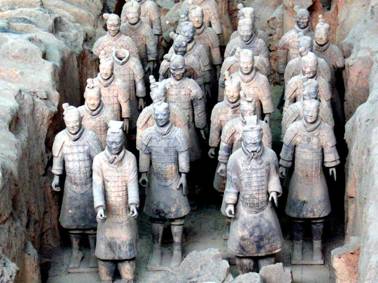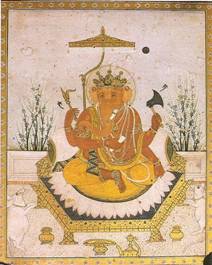The terracotta warriors: a triumph of invention or one of the world’s most epic failures of imagination? Testament to China’s once formidable powers of creation and innovation, or just an early prelude to the assembly line cultural production we see in China today? My second day in Xian, I was with the American art students at the site of a Shaanxi farmer’s shocking discovery. Our purple suited guide was explaining the history of the warriors, and for the second time in 12 months, I found myself marveling at the relentless and warped power that drove an ancient people to spend forty years and 700,000 lives to make a ceramic army to protect the teenaged emperor in perpetuity. The guide was explaining that, in fact, the pottery protection approach was in certain ways a humane one - despite costing several generations their lives and filling nearby pits with the bones of ex-employees – up until this point the emperor was buried with his real army, an act which must’ve meant the new emperor had a whole lot of positions to fill when he ascended to the throne. One of the students turned to me with a disappointed look on his face, “they could have made these so much cooler,” he shook his head a little, “they could’ve made anything – they could’ve made them like Transformers or something cool!”

Photo: Ingo.staudacher
At the behest of the first Qin emperor, a clay army was forged out of four decades of back breaking forced labor, at a staggering expense to the natural environment (it takes a lot of wood to keep kilns burning day and night at 1800 degrees for forty years), and what one assumes was great detriment to the economy – what if these 700,000 workers had been able to work jobs that had benefited more than a single man? Yet, despite this maniacal exercise of power and tyrannical implementation of bureaucracy, the warriors have become, to my mind, evidence of a massive failure of imagination. Despite the seemingly enhanced stature of many of the soldiers (they range in height from 6’ to 6’5”) and some pretty sweet mustaches that I have a hard time believing were actually being grown with such success (what happened to mustaches in China?) they seem to be faithful reproductions of the emperor’s troops.
Greek gods are fantastic amalgamations of humans and animals, with superpower accessories like lightning bolts, or the ability to fly, or enter and exit the underworld at will. Indian mythology is full of many creatures with extra arms, or elephant trunks who can float above mortals, acting out their own versions of the mile high club. But aside from the ‘staches, the warriors are pretty boring; standing stiffly in endless rows, hands clutching emptily at wood weapons which decayed centuries ago. Although each warrior was customized to express an individual personality, they were all stamped from the same mold, and when you stare down into the massive pits at the slightly crooked ranks of soldiers you don’t notice the slight differences in hairstyles or facial features.

This image of Ga?e?a actually looks like something a 13 year old would design
Looking at some of China’s other famous landmarks, this same emphasis on quantity over creativity seems to prevail. They greatness of the Great Wall lies in its length. Its history aside, Tiananmen Square is notable because it’s really wide. Qin Shi Huang may have broken the code when he decided to march into eternity leading a ceramic army instead of a recently murdered
It’s also difficult to swallow the idea that Qin Shi Huang and his advisers were acting out of great compassion when they decided to make the afterlife army out of clay and not real soldiers. I’m betting forty years of forced labor killed a lot more people than just dedicating a couple of regiments to afterlife duties. Especially when you find out his still unexcavated underground palace featured rivers of mercury.
While traveling often shows us how flexible we are, how capable we are of challenging our normal patterns, it also shows us how rigid those bonds can be. How many of us found ourselves at a fast food restaurant we’d rarely eat back home within a month of landing in China? Humans are creatures of habit, and our individual codes, while they may seem so obvious to others (build a giant clay robot with the face of a lion and the tail of a stegosaurus; go to that little noodle stall down the block; get out of the hotel and into the streets) are often impossible for us to decipher ourselves.
***
Related Links
Breaking the Code: Part 1
Best of China in Ten Days: Day 4 and 5
Xi'an: A Big Small City
Warning:The use of any news and articles published on eChinacities.com without written permission from eChinacities.com constitutes copyright infringement, and legal action can be taken.
All comments are subject to moderation by eChinacities.com staff. Because we wish to encourage healthy and productive dialogue we ask that all comments remain polite, free of profanity or name calling, and relevant to the original post and subsequent discussion. Comments will not be deleted because of the viewpoints they express, only if the mode of expression itself is inappropriate.
Please login to add a comment. Click here to login immediately.